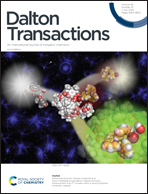Influence of the chain length and metal : ligand ratio on the self-organization processes of Cu2+ complexes of [1 + 1] 1H-pyrazole azamacrocycles†
Abstract
Three new [1 + 1] macrocycles formed by the reaction of 1H-3,5-bis(chloromethyl)pyrazole with the tosylated amines 1,4,7,10-tetraazadecane (L1), 1,4,8,11-tetraazaundecane (L2) and 1,5,10,14-tetraazatetradecane (L3) are described. Potentiometric studies and HR-ESI-Mass spectrometry show the formation of dimeric binuclear Cu2+ complexes whose organization depends on the type of hydrocarbon chains connecting the amine groups. Furthermore, trinuclear or/and tetranuclear complexes are formed depending also on the length of the polyaminic bridge and on the sequence of the hydrocarbon chains. The crystal structures of the [2 + 2] [Cu2(H(H−1L2))2](ClO4)4·4H2O (1) and [Cu2(H−1L2)2](ClO4)2 (2) complexes show in both of them two macrocycles self-assembled by the metal ions which interconnect their pyrazolate fragments that behave as bis(monodentate) ligands. While in 1 one central amine of each macrocycle binds to the axial position of a distorted square-pyramid and the other ones remain protonated, in 2 all the amine groups are involved in the coordination giving rise to a strongly distorted octahedral geometry. Paramagnetic 1H NMR measurements support that these structures also form in solution. Interestingly, tetranuclear complexes [Cu4(H−1L4)2(OH)2.08](ClO4)2.92Br0.54Cl0.46 (3) and [Pd2.39Cu1.61(H−1L4)2(OH)2](ClO4)2Cl1.33Br0.67·2.87H2O (4) have been isolated for the macrocycle containing the 1,5,9,13-tetraamine chain (L4). 3 has two binucleating units, one of them formed by the pyrazolate moieties and their neighbouring secondary amines and the other by the two central amines of both macrocycles. This latter Cu2+ coordination site is completed by two hydroxide anions as bridging ligands. 4 was obtained from a solution prepared to achieve full formation of the dimeric cage [Cu2(H−1(HL4))2]4+ by addition of K2PdCl4. The Pd2+ ion due to its softer acidic characteristics displaces the Cu2+ ions from the pyrazolate site. UV-vis spectroscopy suggests that the exchange is completed at room temperature after one hour.
![Graphical abstract: Influence of the chain length and metal : ligand ratio on the self-organization processes of Cu2+ complexes of [1 + 1] 1H-pyrazole azamacrocycles](/en/Image/Get?imageInfo.ImageType=GA&imageInfo.ImageIdentifier.ManuscriptID=D0DT01056A&imageInfo.ImageIdentifier.Year=2020)


 Please wait while we load your content...
Please wait while we load your content...